助动词情态动词[上学期]
图片预览
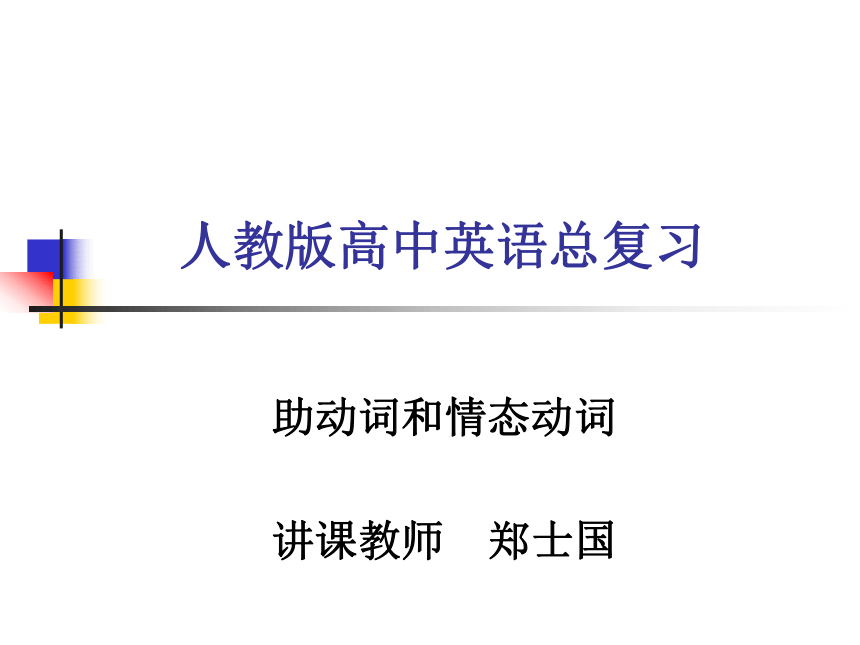
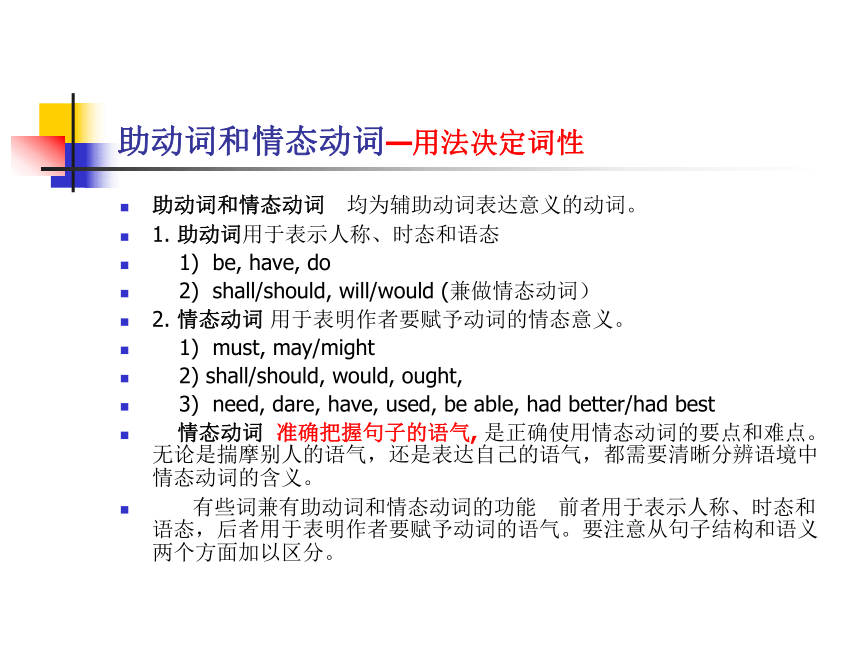
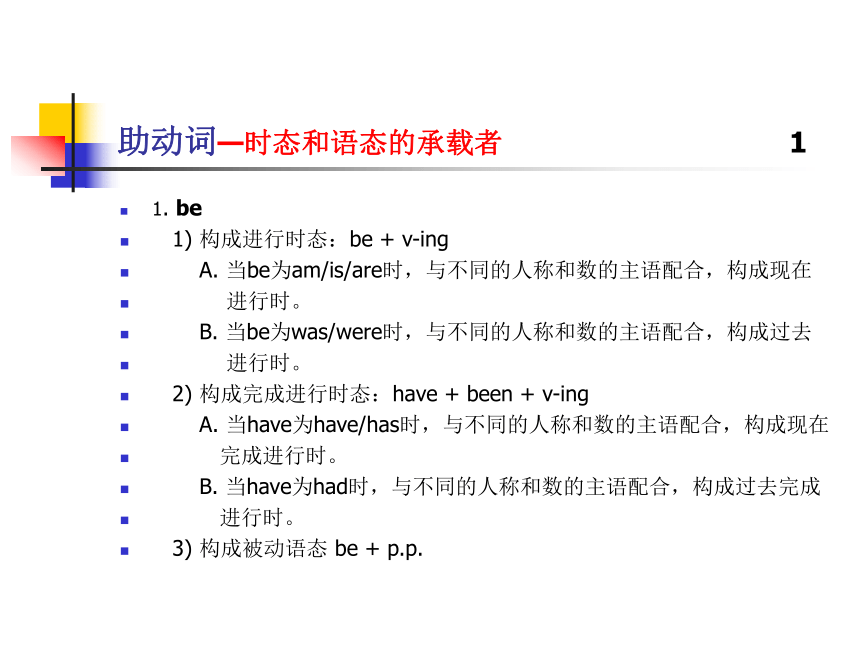
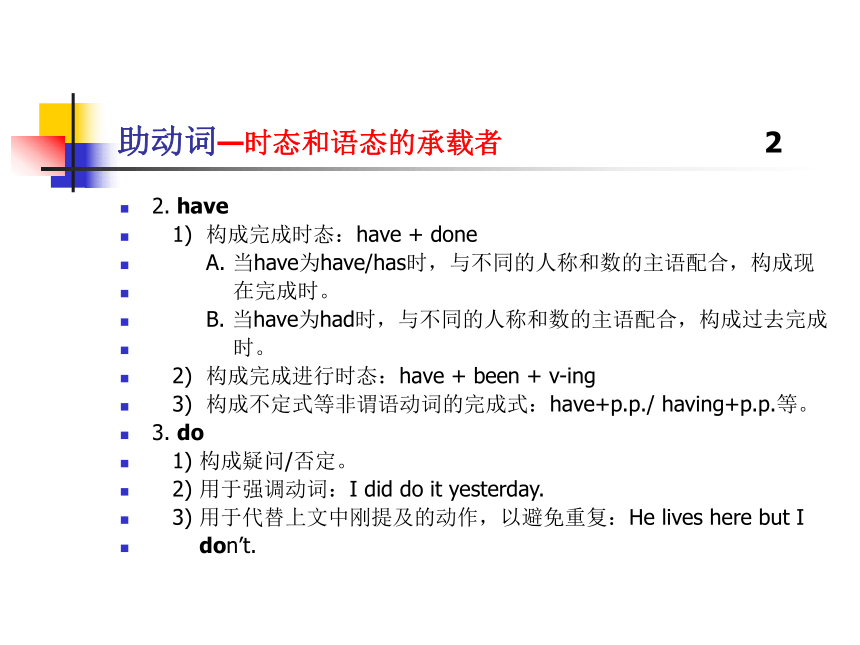
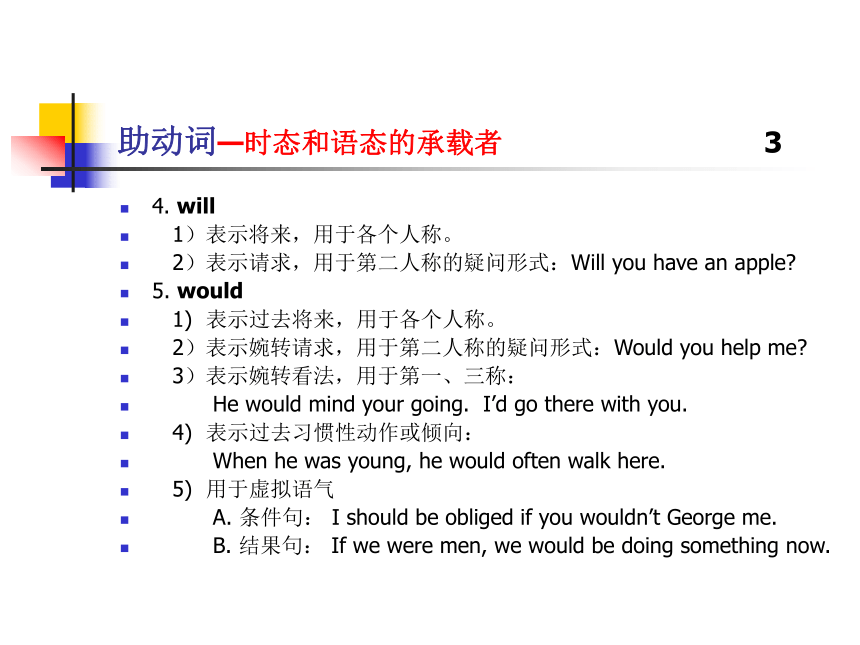
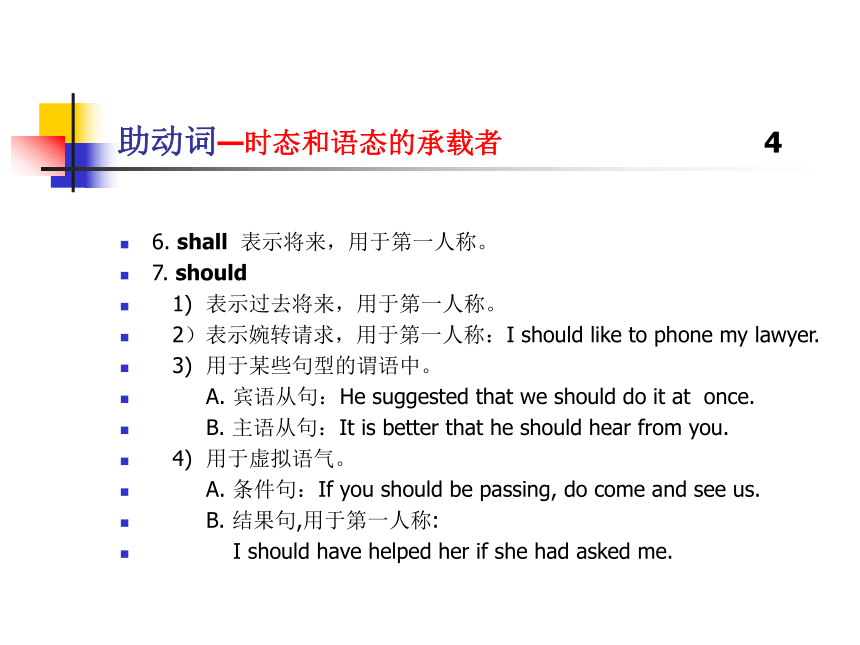
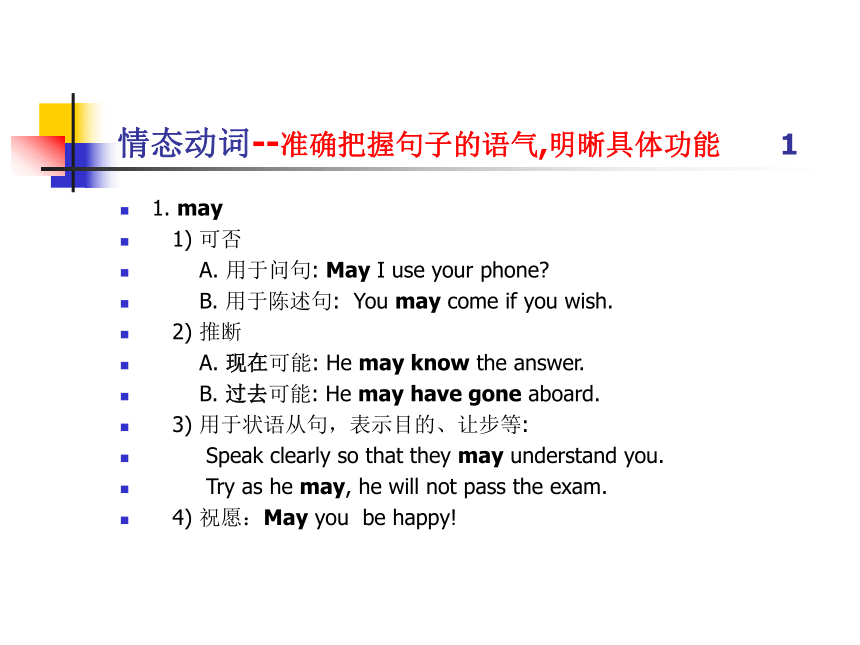
文档简介
课件18张PPT。 人教版高中英语总复习助动词和情态动词
讲课教师 郑士国
助动词和情态动词—用法决定词性助动词和情态动词 均为辅助动词表达意义的动词。
1. 助动词用于表示人称、时态和语态
1) be, have, do
2) shall/should, will/would (兼做情态动词)
2. 情态动词 用于表明作者要赋予动词的情态意义。
1) must, may/might
2) shall/should, would, ought,
3) need, dare, have, used, be able, had better/had best
情态动词 准确把握句子的语气, 是正确使用情态动词的要点和难点。无论是揣摩别人的语气,还是表达自己的语气,都需要清晰分辨语境中情态动词的含义。
有些词兼有助动词和情态动词的功能 前者用于表示人称、时态和语态,后者用于表明作者要赋予动词的语气。要注意从句子结构和语义两个方面加以区分。
助动词—时态和语态的承载者 11. be
1) 构成进行时态:be + v-ing
A. 当be为am/is/are时,与不同的人称和数的主语配合,构成现在
进行时。
B. 当be为was/were时,与不同的人称和数的主语配合,构成过去
进行时。
2) 构成完成进行时态:have + been + v-ing
A. 当have为have/has时,与不同的人称和数的主语配合,构成现在
完成进行时。
B. 当have为had时,与不同的人称和数的主语配合,构成过去完成
进行时。
3) 构成被动语态 be + p.p.助动词—时态和语态的承载者 22. have
1) 构成完成时态:have + done
A. 当have为have/has时,与不同的人称和数的主语配合,构成现
在完成时。
B. 当have为had时,与不同的人称和数的主语配合,构成过去完成
时。
2) 构成完成进行时态:have + been + v-ing
3) 构成不定式等非谓语动词的完成式:have+p.p./ having+p.p.等。
3. do
1) 构成疑问/否定。
2) 用于强调动词:I did do it yesterday.
3) 用于代替上文中刚提及的动作,以避免重复:He lives here but I
don’t.助动词—时态和语态的承载者 34. will
1)表示将来,用于各个人称。
2)表示请求,用于第二人称的疑问形式:Will you have an apple?
5. would
1) 表示过去将来,用于各个人称。
2)表示婉转请求,用于第二人称的疑问形式:Would you help me?
3)表示婉转看法,用于第一、三称:
He would mind your going. I’d go there with you.
4) 表示过去习惯性动作或倾向:
When he was young, he would often walk here.
5) 用于虚拟语气
A. 条件句: I should be obliged if you wouldn’t George me.
B. 结果句: If we were men, we would be doing something now.
助动词—时态和语态的承载者 4
6. shall 表示将来,用于第一人称。
7. should
1) 表示过去将来,用于第一人称。
2)表示婉转请求,用于第一人称:I should like to phone my lawyer.
3) 用于某些句型的谓语中。
A. 宾语从句:He suggested that we should do it at once.
B. 主语从句:It is better that he should hear from you.
4) 用于虚拟语气。
A. 条件句:If you should be passing, do come and see us.
B. 结果句,用于第一人称:
I should have helped her if she had asked me.
情态动词--准确把握句子的语气,明晰具体功能 11. may
1) 可否
A. 用于问句: May I use your phone?
B. 用于陈述句: You may come if you wish.
2) 推断
A. 现在可能: He may know the answer.
B. 过去可能: He may have gone aboard.
3) 用于状语从句,表示目的、让步等:
Speak clearly so that they may understand you.
Try as he may, he will not pass the exam.
4) 祝愿:May you be happy!情态动词--明晰每一个情态动词的具体功能 22. might 1) 可否, 含义比may委婉。
A. 用于问句:Might I use your phone?
B. 用于陈述句:You might call at the chemist on the way home.
2)may的过去式, 用于间接引语:
A. 表示“可以”: I thought you might stay here.
B. 表示“可能”: He said he might be late.
C. 用于状语从句,表示目的、让步等:
I lent him $500 in order he might go for a holiday.
Try as he might, he could not pass the exam.
3) 推断, 与may用法相同。
A. 现在可能: He might know the answer.
B. 过去可能: He might have gone aboard.
情态动词--明晰每一个情态动词的具体功能 3 4) 轻微批评、抱怨。
A. 针对现在:You might tell me if you’re going to be late.
B. 针对过去:You might at least have phoned me if you’re not
coming.
3. must
1) 必须、一定。
A. 指现在或将来:
You must give up smoking. I must remember to post the
letter.
B. 指过去用have的过去式had(比用must含义清楚):
I had to go to see the doctor.
2) 否定式must not/mustn’t表示“禁止、一定不”:
Cars must not park in front of the entrance. We mustn’t be
late.情态动词--明晰每一个情态动词的具体功能 4 3) 推断。
A. 现在可能: He must know the answer.
B. 过去可能: We must have read the same report.
4) 责任、义务,与should/ought含义类似:
You must see the film; it’s wonderful.
4. should /ought
1) 责任、义务
A. 指现在或将来:
The police should do something about it.
The machine ought to be cleaned once a week.
B. 指过去:
You should have checked the time before you left.
You ought to have told me about it earlier.
情态动词--明晰每一个情态动词的具体功能 5 2) ought还用于表示揣测。
He ought to pass the exam. The water ought to have boiled
now.
We ought to be hearing from Jane soon.
5. shall
1) 疑问形式征求意见,用于第一人称:
What time shall I come?
Let’s do it again, shall we?
2) 表示规定、许诺、命令、警告、决心等,用于各个人称:
I shall write to you at the end of the month.
If you want a computer, you shall have one.
A player shall be sent off for using bad language. need
情态动词--明晰每一个情态动词的具体功能 66. need
1) 表示“不必”,
A. 用于否定句: You needn’t come to the meeting.
B. 用于含有半否定词的句子:
C. 用于宾语从句时,主句为过去时,依然用need:
He says/said I needn’t pay till the 30th.
2) 用于疑问句: Need we come tomorrow?
7. dare
1) 表示“敢”,
A. 用于否定句。
I daren’t ask her to do that.
B. 用于含有半否定词的句子:
I hardly dare to think of it.
情态动词--明晰每一个情态动词的具体功能 7 2) 用于疑问句和条件句:
Dare you interrupt him? I wonder if she dared come home.
3) 用于I dare say, don’t you dare结构:
I dare say you’re right. Don’t you dare touch that vase.
8 have 表示客观上的必要性,后接带to的不定式.
1) 肯定式:We have to be careful in such matters.
2) 否定式和疑问式:
You don’t have to get up early. Do you have to leave so soon?
3) 可用于各种时态: We’ll have to help him as much as we can.
4) 可用于各种语态: A lot of letters had to be answered.
5) 可用于复合谓语: We may have to cancel the plan.
情态动词--明晰每一个情态动词的具体功能 89. had better/ best, ‘d better
1) 后接不定式的一般式或进行式(均不带to)。
A.接不定式的一般式:
We’d better go before it gets dark.
What had we better do?
2) 接不定式的进行式: I think we’d better be going.
3) had best 与had better相似:I had best be going now.
试题与思路 (助动词和情态动词) 11. --- Is John coming by train?
--- He should, but he ___ not. He likes driving his car.
A. must B. can C. need D. may
选D。从上下文coming by train和driving his car可知有两种可能性,则关于driving his car的推测属于not sure一类, 因此选D。
2. It has been announced that candidates ___ remain in their seats
until all the papers have been collected.
A. can B. will C. may D. shall
选D。根据上下文可知空格处应有一个表示意图、警告等含义的词语,shall就是这样一个词语,它可用于各种人称。试题与思路 (助动词和情态动词) 23. Oh, I’m not feeling well in the stomach. I ___ so much fried chicken just now.
A. shouldn’t eat B. mustn’t have eaten C. shouldn’t have eaten D. mustn’t eat
选C。根据语境“I ‘m not feeling well可知言者感到后悔,即动作应是发生在过去,因此应选”情态动词+完成式的不定式”的结构来表示对过去的推断。又,mustn’t表示“禁止”,所以不可选。
4. --- Do you think our basketball played very well yesterday?
--- ___.
A. They were not nervous at all B. They were still young
C. They played naturally D. They couldn’t have done better
选D。问者询问“昨天球打得如何”,应用对过去的情况的判断,故应选D。其余三选项所答非所问。又,not+比较级表示强调性的肯定。
试题与思路 (助动词和情态动词) 35. He ___ here by now, for he took the early bus.
A. ought to have arrived B. must arrive
C. may have arrived D. can arrive
选C。从took the early bus可知,arrive的动作应发生于过去,即句子英表示对过去情况的推断,所以应该用含有完成式的不定式的选项。ought表示“责任、义务”,不用于表示对过去的推测,只有may have arrived 合理。
6. I wonder how he ___ that to the teacher.
A. dare to say B. dare say C. not dare say D. dared say
选D。此句从句中的动作应发生于过去,故dare应该用过去式dared。若发生于现在,则应该用dare say(情态动词用法)或dares to say(行为动词用法,现在时) 。又,dare的情态动词用法否定式应为dare not do sth。
试题与思路 (助动词和情态动词) 47. --- I saw Ann in the library yesterday.
--- You ___ her; she is still abroad.
A. must not see B. can’t have seen C. mustn’t have seen D. couldn’t see
选B。由“yesterday” 可知应是对过去情况的推断,因此应该用“情态动词+完成式的不定式”的结构来表示;又因“mustn‘t”表示“禁止”而不可用。
8. I ___ them, but I wasn’t able to.
A. ought to have helped B. must have helped
C. might help D. needn’t have helped
选A。应该用“情态动词+完成式的不定式”的结构来表示对过去情况的推断。从“wasn’t able to” 可知言者原要“help them”, 但限于能力而未实现;从表达 “责任、义务”需要,应该用should/ought这样的情态动词。
讲课教师 郑士国
助动词和情态动词—用法决定词性助动词和情态动词 均为辅助动词表达意义的动词。
1. 助动词用于表示人称、时态和语态
1) be, have, do
2) shall/should, will/would (兼做情态动词)
2. 情态动词 用于表明作者要赋予动词的情态意义。
1) must, may/might
2) shall/should, would, ought,
3) need, dare, have, used, be able, had better/had best
情态动词 准确把握句子的语气, 是正确使用情态动词的要点和难点。无论是揣摩别人的语气,还是表达自己的语气,都需要清晰分辨语境中情态动词的含义。
有些词兼有助动词和情态动词的功能 前者用于表示人称、时态和语态,后者用于表明作者要赋予动词的语气。要注意从句子结构和语义两个方面加以区分。
助动词—时态和语态的承载者 11. be
1) 构成进行时态:be + v-ing
A. 当be为am/is/are时,与不同的人称和数的主语配合,构成现在
进行时。
B. 当be为was/were时,与不同的人称和数的主语配合,构成过去
进行时。
2) 构成完成进行时态:have + been + v-ing
A. 当have为have/has时,与不同的人称和数的主语配合,构成现在
完成进行时。
B. 当have为had时,与不同的人称和数的主语配合,构成过去完成
进行时。
3) 构成被动语态 be + p.p.助动词—时态和语态的承载者 22. have
1) 构成完成时态:have + done
A. 当have为have/has时,与不同的人称和数的主语配合,构成现
在完成时。
B. 当have为had时,与不同的人称和数的主语配合,构成过去完成
时。
2) 构成完成进行时态:have + been + v-ing
3) 构成不定式等非谓语动词的完成式:have+p.p./ having+p.p.等。
3. do
1) 构成疑问/否定。
2) 用于强调动词:I did do it yesterday.
3) 用于代替上文中刚提及的动作,以避免重复:He lives here but I
don’t.助动词—时态和语态的承载者 34. will
1)表示将来,用于各个人称。
2)表示请求,用于第二人称的疑问形式:Will you have an apple?
5. would
1) 表示过去将来,用于各个人称。
2)表示婉转请求,用于第二人称的疑问形式:Would you help me?
3)表示婉转看法,用于第一、三称:
He would mind your going. I’d go there with you.
4) 表示过去习惯性动作或倾向:
When he was young, he would often walk here.
5) 用于虚拟语气
A. 条件句: I should be obliged if you wouldn’t George me.
B. 结果句: If we were men, we would be doing something now.
助动词—时态和语态的承载者 4
6. shall 表示将来,用于第一人称。
7. should
1) 表示过去将来,用于第一人称。
2)表示婉转请求,用于第一人称:I should like to phone my lawyer.
3) 用于某些句型的谓语中。
A. 宾语从句:He suggested that we should do it at once.
B. 主语从句:It is better that he should hear from you.
4) 用于虚拟语气。
A. 条件句:If you should be passing, do come and see us.
B. 结果句,用于第一人称:
I should have helped her if she had asked me.
情态动词--准确把握句子的语气,明晰具体功能 11. may
1) 可否
A. 用于问句: May I use your phone?
B. 用于陈述句: You may come if you wish.
2) 推断
A. 现在可能: He may know the answer.
B. 过去可能: He may have gone aboard.
3) 用于状语从句,表示目的、让步等:
Speak clearly so that they may understand you.
Try as he may, he will not pass the exam.
4) 祝愿:May you be happy!情态动词--明晰每一个情态动词的具体功能 22. might 1) 可否, 含义比may委婉。
A. 用于问句:Might I use your phone?
B. 用于陈述句:You might call at the chemist on the way home.
2)may的过去式, 用于间接引语:
A. 表示“可以”: I thought you might stay here.
B. 表示“可能”: He said he might be late.
C. 用于状语从句,表示目的、让步等:
I lent him $500 in order he might go for a holiday.
Try as he might, he could not pass the exam.
3) 推断, 与may用法相同。
A. 现在可能: He might know the answer.
B. 过去可能: He might have gone aboard.
情态动词--明晰每一个情态动词的具体功能 3 4) 轻微批评、抱怨。
A. 针对现在:You might tell me if you’re going to be late.
B. 针对过去:You might at least have phoned me if you’re not
coming.
3. must
1) 必须、一定。
A. 指现在或将来:
You must give up smoking. I must remember to post the
letter.
B. 指过去用have的过去式had(比用must含义清楚):
I had to go to see the doctor.
2) 否定式must not/mustn’t表示“禁止、一定不”:
Cars must not park in front of the entrance. We mustn’t be
late.情态动词--明晰每一个情态动词的具体功能 4 3) 推断。
A. 现在可能: He must know the answer.
B. 过去可能: We must have read the same report.
4) 责任、义务,与should/ought含义类似:
You must see the film; it’s wonderful.
4. should /ought
1) 责任、义务
A. 指现在或将来:
The police should do something about it.
The machine ought to be cleaned once a week.
B. 指过去:
You should have checked the time before you left.
You ought to have told me about it earlier.
情态动词--明晰每一个情态动词的具体功能 5 2) ought还用于表示揣测。
He ought to pass the exam. The water ought to have boiled
now.
We ought to be hearing from Jane soon.
5. shall
1) 疑问形式征求意见,用于第一人称:
What time shall I come?
Let’s do it again, shall we?
2) 表示规定、许诺、命令、警告、决心等,用于各个人称:
I shall write to you at the end of the month.
If you want a computer, you shall have one.
A player shall be sent off for using bad language. need
情态动词--明晰每一个情态动词的具体功能 66. need
1) 表示“不必”,
A. 用于否定句: You needn’t come to the meeting.
B. 用于含有半否定词的句子:
C. 用于宾语从句时,主句为过去时,依然用need:
He says/said I needn’t pay till the 30th.
2) 用于疑问句: Need we come tomorrow?
7. dare
1) 表示“敢”,
A. 用于否定句。
I daren’t ask her to do that.
B. 用于含有半否定词的句子:
I hardly dare to think of it.
情态动词--明晰每一个情态动词的具体功能 7 2) 用于疑问句和条件句:
Dare you interrupt him? I wonder if she dared come home.
3) 用于I dare say, don’t you dare结构:
I dare say you’re right. Don’t you dare touch that vase.
8 have 表示客观上的必要性,后接带to的不定式.
1) 肯定式:We have to be careful in such matters.
2) 否定式和疑问式:
You don’t have to get up early. Do you have to leave so soon?
3) 可用于各种时态: We’ll have to help him as much as we can.
4) 可用于各种语态: A lot of letters had to be answered.
5) 可用于复合谓语: We may have to cancel the plan.
情态动词--明晰每一个情态动词的具体功能 89. had better/ best, ‘d better
1) 后接不定式的一般式或进行式(均不带to)。
A.接不定式的一般式:
We’d better go before it gets dark.
What had we better do?
2) 接不定式的进行式: I think we’d better be going.
3) had best 与had better相似:I had best be going now.
试题与思路 (助动词和情态动词) 11. --- Is John coming by train?
--- He should, but he ___ not. He likes driving his car.
A. must B. can C. need D. may
选D。从上下文coming by train和driving his car可知有两种可能性,则关于driving his car的推测属于not sure一类, 因此选D。
2. It has been announced that candidates ___ remain in their seats
until all the papers have been collected.
A. can B. will C. may D. shall
选D。根据上下文可知空格处应有一个表示意图、警告等含义的词语,shall就是这样一个词语,它可用于各种人称。试题与思路 (助动词和情态动词) 23. Oh, I’m not feeling well in the stomach. I ___ so much fried chicken just now.
A. shouldn’t eat B. mustn’t have eaten C. shouldn’t have eaten D. mustn’t eat
选C。根据语境“I ‘m not feeling well可知言者感到后悔,即动作应是发生在过去,因此应选”情态动词+完成式的不定式”的结构来表示对过去的推断。又,mustn’t表示“禁止”,所以不可选。
4. --- Do you think our basketball played very well yesterday?
--- ___.
A. They were not nervous at all B. They were still young
C. They played naturally D. They couldn’t have done better
选D。问者询问“昨天球打得如何”,应用对过去的情况的判断,故应选D。其余三选项所答非所问。又,not+比较级表示强调性的肯定。
试题与思路 (助动词和情态动词) 35. He ___ here by now, for he took the early bus.
A. ought to have arrived B. must arrive
C. may have arrived D. can arrive
选C。从took the early bus可知,arrive的动作应发生于过去,即句子英表示对过去情况的推断,所以应该用含有完成式的不定式的选项。ought表示“责任、义务”,不用于表示对过去的推测,只有may have arrived 合理。
6. I wonder how he ___ that to the teacher.
A. dare to say B. dare say C. not dare say D. dared say
选D。此句从句中的动作应发生于过去,故dare应该用过去式dared。若发生于现在,则应该用dare say(情态动词用法)或dares to say(行为动词用法,现在时) 。又,dare的情态动词用法否定式应为dare not do sth。
试题与思路 (助动词和情态动词) 47. --- I saw Ann in the library yesterday.
--- You ___ her; she is still abroad.
A. must not see B. can’t have seen C. mustn’t have seen D. couldn’t see
选B。由“yesterday” 可知应是对过去情况的推断,因此应该用“情态动词+完成式的不定式”的结构来表示;又因“mustn‘t”表示“禁止”而不可用。
8. I ___ them, but I wasn’t able to.
A. ought to have helped B. must have helped
C. might help D. needn’t have helped
选A。应该用“情态动词+完成式的不定式”的结构来表示对过去情况的推断。从“wasn’t able to” 可知言者原要“help them”, 但限于能力而未实现;从表达 “责任、义务”需要,应该用should/ought这样的情态动词。
